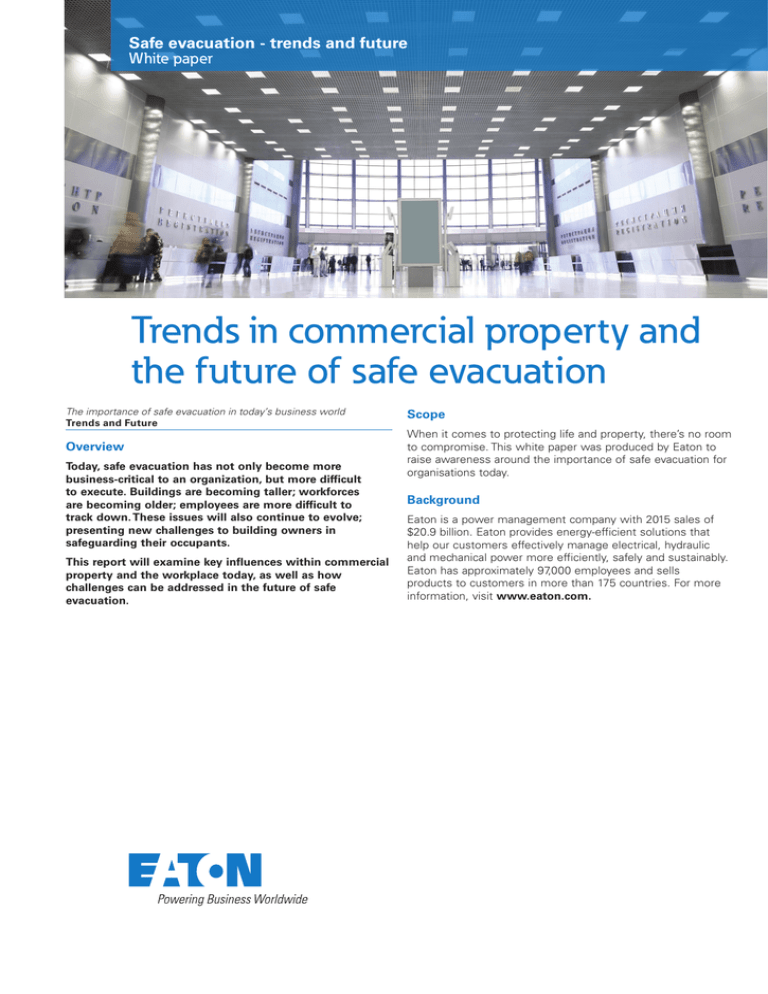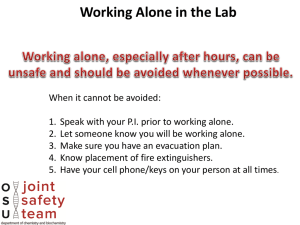
Safe evacuation - trends and future
White paper
Trends in commercial property and
the future of safe evacuation
The importance of safe evacuation in today’s business world Trends and Future
Overview
Today, safe evacuation has not only become more
business-critical to an organization, but more difficult
to execute. Buildings are becoming taller; workforces
are becoming older; employees are more difficult to
track down. These issues will also continue to evolve;
presenting new challenges to building owners in
safeguarding their occupants.
This report will examine key influences within commercial
property and the workplace today, as well as how
challenges can be addressed in the future of safe
evacuation.
Scope
When it comes to protecting life and property, there’s no room
to compromise. This white paper was produced by Eaton to
raise awareness around the importance of safe evacuation for
organisations today.
Background
Eaton is a power management company with 2015 sales of
$20.9 billion. Eaton provides energy-efficient solutions that
help our customers effectively manage electrical, hydraulic
and mechanical power more efficiently, safely and sustainably.
Eaton has approximately 97,000 employees and sells
products to customers in more than 175 countries. For more
information, visit www.eaton.com.
White Paper WP455001EN
Effective April 2016
Trends in commercial property and the changing nature of risk
The business and commercial property landscape is changing. This section will examine four key trends within commercial property
and the workplace to show not only how safe evacuation remains a critical aspect in the preservation of business, but how keeping
employees’ safe during an emergency has become more challenging for organisations today.
Number of new buildings over 100 metres in height, London
1. The nature of commercial property
It was estimated that $196 billion would be invested into UK
commercial property development in 2015. By 2020, the UK
will spend $228 billion, nearly a 15% increase from 2015.1 More
commercial property means more inhabitants that need to be
evacuated safely in the event of an emergency.
Built
Under construction
Proposed
Commercial property is also being built in all sorts of shapes
and sizes, dictated by urbanisation and acute population growth.
Urbanisation in the UK has increased from 79.6% in 2004 to
82.3% in 2014. This is largely down to London increasing in
population by nearly two million in the past 25 years.2
As a result of urbanisation and population growth, buildings are
now being constructed taller than ever before so they remain
within the constraints of the Green Belt. Today, 263 tall buildings
over 20 storeys are proposed, approved or under construction
within Greater London, with 70 of them currently being built.3
1960s
1970s
1980s
1990s
2000s
2010s
Figure 1. The increasing number of tall commercial buildings built
across London from the turn of the millennium 4
300m
Under construction
250m
200m
150m
100m
310m
288m
237m
237m
230m
200m
200m
193m
193m
190m
155m
152m
152m
151m
143m
137m
124m
123m
123m
123m
120m
111m
96m
The Shard
Bishopsgate Tower
(The Pinacle)
1 Canada Square
River South Tower 1
The Heron Tower
8 Canada Square
25 Canada Square
BT Tower
Tower 42
30 St Mary Axe
1 Churchill Place
25 Bank Street
40 Bank Street
10 Upper Bank Street
Guys Tower
City Point
Euston Tower
Cromwell
Launderdale
Shakespeare
London Eye
St Pauls
Big Ben
50m
Figure 2. London’s current assortment of tall buildings in 2015
Tall buildings bring about massive evacuation challenges. In the
event of an emergency, safely evacuating a sky scraper with 49
floors and over 5,000 employees is an incredibly complex and
difficult process. When a building is multiple storeys high, the
stairs act as major constriction points on the escape routes, and
the risk of employees stumbling on stairs is considerably higher
than on a level escape route.
Another trend that is having a significant impact on the process
of evacuation is that new, large commercial buildings are less
like traditional office space, and more like multi-functional hotels
that offer employees a high level of service and comfort. Google’s
proposed plans for its new London office signify the change in
mindset of office space; the plans include an open-air swimming
pool, an indoor football field, a climbing wall and a roof garden.
Multi-functional buildings that include residential and commercial
premises, as well as restaurants and shops are far more
vulnerable to hazards (such as fire) that could lead to a mass
evacuation. For example, in August 2015, 100 restaurant
guests were evacuated from The Shard, Europe’s tallest multi1. IHS Building Construction, March 2015
2. Urban population (% of total), The World Bank, 2014
3. Latest tall buildings figures revealed, New London Architecture, March 2015
2
EATON www.eaton.com
functional skyscraper, when a fire broke out in the restaurant’s
kitchen.5 Thankfully, there were no casualties as all occupants
were evacuated safely. However, this kind of scenario is
likely to become more common as buildings become more
multi-functional.
Looking ahead to the next 10-15 years, towering multi-purpose
‘megacities’ could soon become a reality. A project named
‘Endless City’ (undertaken by SURE Architecture) would see a
giant 300m skyscraper built in London with its own complete
ecosystem. The building would consist of intertwining ramps
leading through business, shopping, entertainment and residential
areas. Although the skyscraper is only at design phase, the
company has earmarked a location close to the City of London.
It would include a raft of public spaces, entertainment zones
and shopping areas to create a ‘vertical city’. If this kind of
development were to go ahead, whilst being a fantastic project
for London and a breakthrough in modern architecture, it would
bring about massive evacuation challenges that would need to be
addressed.
4. London skyscrapers: the ascent of the city, The Economist, 15 February 2014
5. The Shard fire: Diners evacuated from skyscraper restaurants, The Telegraph, 4
August 2015.
White Paper WP455001EN
Effective April 2016
2. Flexible working practices
Almost all UK firms offer some form of flexible working, as the
fight to retain highly skilled staff, boost productivity and engage
employees has become fiercer. According to research carried out
by CIPD (Chartered Institute of Personnel and Development), all
large employers offer flexible working to some employees, as do
95% of medium-sized organisations.6 This, combined with new UK
legislation around employees’ rights to flexible working, means
that 20 million more people can now work flexibly.
Flexible working means that employees’ whereabouts are more
uncertain, which in turn, makes executing safe evacuation difficult.
In many companies, the sign in/sign out system has become
inadequate, and offices that offer an array of services (such as
swimming pools, gyms and relaxation areas) make monitoring
employees’ location even more difficult.
Even when employees are within the building, ‘hot desking’
has been introduced to optimise floor space, which means that
employees simply work at whichever desk is free. Occupants
are therefore concentrated in close proximity, and exit routes
can become blocked in the event of an emergency. Furthermore,
occupants are more likely to be unfamiliar with the area of the
building they are working in, particularly in organisations where
there is a high turnover of freelance staff, so exit route signage
may need to be improved.
3. Disabled people and an ageing population
With rapid change in the workforce demographic, employers
across Europe are having to adapt and provide for an increasingly
ageing workforce with decreased mobility, as well as make
adjustments in the workplace for disabled employees.
Elderly employees
With life expectancy increasing and the pressure on pension
schemes greater than ever before, the default retirement age of
65 has now been phased out as employees are forced to work for
longer. In the next 30 years, over 20 million British people will be
over the age of 65, and many of them will still be working.7
According to the Department for Work and Pensions’ Labour Force
Survey, the employment rate for people aged between 50 and
64 increased from 62% in 2001 to 67% in 2013.8 Over the same
period, the employment rate for people aged 65 and over rose
from 5% in 2001, to nearly 10% in 2013.
An ageing working population, combined with the larger and more
complex commercial buildings of today, brings about evacuation
challenges in the event of an emergency.
Elderly employees are not only less mobile, but also more likely
to suffer from deteriorating vision or to be hard of hearing. In this
case, much higher levels of emergency lighting will be required, or
visual alarm devices (VADs) in addition to audible signals.
Disabled people
who are wheelchair-bound require assistance for stairways, as
many buildings have a program in place that deactivates lifts in the
event of an alarm being sounded.
For the deaf or hard-of-hearing, the risks are also considerably
higher when they are alone without others to warn them of an
emergency. According to Action on Hearing Loss (AOHL), formerly
known as the Royal National Institute for Deaf People (RNID),
there are almost eight million deaf or hard-of-hearing people in
the UK alone.10 Almost 800,000 of these suffer from ‘severe to
profound deafness’. It is also important to be aware that the risk
of not hearing an audible alarm also applies to those working in
noisy environments such as factories, or to people wearing ear
defenders or headphones. Any delayed evacuation could be fatal,
as minutes (or even seconds) can make all the difference in an
emergency situation.
This is a complicated landscape to navigate, and relevant
stakeholders in building safety are therefore encouraged to involve
people with disabilities at all stages of devising, practicing and
implementing a Personal Emergency Evacuation Plan (PEEP).11
4. Warehouse growth and regulation
The number of large warehouses that are susceptible to fire are
growing, largely because of the boom in e-commerce.
In the UK, e-commerce accounted for 13 per cent of total retail
sales in 2014, and will reach 18 per cent by 2018.12 As a result,
modern ‘urban’ warehouses are being built all around the UK to
accommodate this growth. The various logistics, manufacturing
and engineering businesses that occupy these warehouses should
make it an absolute priority to ensure they have robust evacuation
strategies in place.
Today’s warehouse is an assemblage of highly evolved automation
technologies and activities include cross-docking, palletizing,
kitting, tagging, and identifying products. All of these various
processes are aimed at maximizing efficiency and productivity,
rather than the mitigation of fire.
Added to this, regulation of sprinkler systems in UK warehouses
only requires buildings over 30m in height (or any warehouse
larger than 20,000m²) to be fitted with a sprinkler system (see
Figure 3).13 Therefore, when a fire does break out, it can spread
extremely quickly and have disastrous consequences.
Given the limitations of fire suppression equipment across many
warehouses in the UK, evacuation strategies are even more
critical, and even businesses that work with suppliers (that have
warehouses) should carry out audits to ensure they have the right
evacuation procedures in place.
Norway
Netherlands
Germany
France
Denmark
Taking precautions to protect people with disabilities is a priority
that is becoming increasingly acute. However, whilst access to
buildings for disabled people is a well-known issue (and something
that the majority of businesses are aware of) providing support for
disabled people to exit buildings is often overlooked.
According to Government figures, there are now more than 3.1
million disabled people in employment in the UK.9 In 2015, a
year-on-year increase of 141,000 disabled people in work was
announced; equivalent to nearly 400 per day. Due to the varied
nature of disabilities, a diverse set of requirements should be
considered. Exit routes, for example, are of vital concern. Those
Figure 3. The proportionate size of a warehouse before regulation
stipulates that sprinklers are required
6. Flexible working provision and uptake, Survey report, Chartered Institute of
Personnel and Development, May 2012.
7. Ageing of the UK population, Office for National Statistics (ONS), June 2015.
8. Older Workers Statistical Information Booklet 2013, Department for Work &
Pensions, December 2013.
9. 400 more disabled people in work every day, Department for Work & Pensions, 20
February 2015.
10. Facts and figures on hearing loss and tinnitus, Action on Hearing Loss, July 2011.
11. Fire Safety Law: The Evacuation of Disabled People from Buildings, Department of
Health, Social Services and Public Safety, 2011.
12. Retail sales worldwide will top $22 trillion this year, Emarketer, 23 December 2014.
13. Legislation, British Automatic Fire Sprinkler Association (BAFSA), website accessed
October 2015 Spain
Scotland
England & Wales
EATON www.eaton.com
3
White Paper WP455001EN
Effective April 2016
5. The future of safe evacuation
Many of the issues and trends discussed in this white paper will
continue to evolve; presenting new challenges to building owners
in safeguarding their occupants. From the demographic of the
UK’s working population, to the way that buildings are being built,
it is likely that the business environment in the UK could be very
different by 2030.
According to the Global Terrorism Index 2014 report, there were
nearly 10,000 terrorist attacks in 2013, a 44 per cent increase
from the previous year.14 With the rise of various militant groups
across the world that are not confined to a specific geography, the
threat of terrorism is becoming a risk that building owners (even in
developed countries such as the UK) are having to contend with.
The regulatory environment is also subject to some big changes
and there are signs that the UK government is tightening
regulation around occupant safety. For example, the current UK
version of the code of practice for emergency lighting is being
reviewed. Included in this review is the safety of the occupants
that are not evacuated in a lighting supply failure, such as
care homes and hotels. These are now classified as ‘stay put’
occupants and in some cases they will need defended locations.
Could we soon see mass notification systems become a necessity
in the UK? Lone wolf attacks seen in the US (such as the Virginia
Tech shootings) have made some US state legislatures pass laws
requiring their schools and universities to implement reliable and
comprehensive mass notification systems (MNS). There is no
reason to believe that such attacks could not also happen in the
UK, and we might see mass notification system solutions in both
universities, and public spaces such as sports arenas, shopping
centers and city squares become a regulatory requirement.
The good news is that there are new technologies available that
facilitate safe evacuation in increasingly complex scenarios. A key
trend for future office buildings is that they will become smarter.
As part of a wider move towards integrated smart city networks
that monitor and optimize energy supply and demand across a
city, buildings will use sensors and control systems to adapt to
changing weather conditions and occupancy levels in real-time.
The connected city and the power of data should mean better
information for threat analysis and response. The devices we all
increasingly carry around, such as smartphones and wearables,
link us in to this information flow and can offer guidance to direct
us away from the hazard threatening the safety in a building.
Another technological trend is dynamic sign technology and
routing control. As a response to the limitations of static exit
lighting, where the exit routes take no account of the actual nature
of the risk, a practical dynamic signage system is more responsive
to a given hazard. In the event of an incident, this system will be
able to indicate the best evacuation route, as well as block access
to dangerous zones.
Building owners today have a plethora of new products available to
safeguard their occupants. In a world that is constantly changing
and evolving, the key to safeguarding occupants is proactivity.
From updating the right evacuation product to suit the profile of a
building, to ensuring proper maintenance of that bespoke product,
it’s vital that building owners act rather than react.
14. Global Terrorism Index 2014, Institute for Economics and Peace, November 2014.
If you would like to find out more,
please contact us at
buildingsuk@eaton.com
Eaton
EMEA Headquarters
Route de la Longeraie 7
1110 Morges, Switzerland
Eaton.eu
All Rights Reserved
Publication No. WP455001EN
Article No. CC3131-1
April 2016
Eaton is a registered trademark.
All other trademarks are property
of their respective owners.
© 2016 Eaton
Disclaimer
This white paper is not intended to be a comprehensive guide to
all aspects of fire safety, but rather a useful source of background
information. Whilst every care has been taken to ensure that the
contents of this document are correct at the time of publication, it
should never be used as any form of substitution for the current
regulatory or legislative documents. Eaton shall be under no liability
whatsoever in respect to such contents. It should be noted that there
may be specific additional requirements that may need to be taken
into account, dependent upon local authority building regulations, fire
authority and/or building risk assessment.



